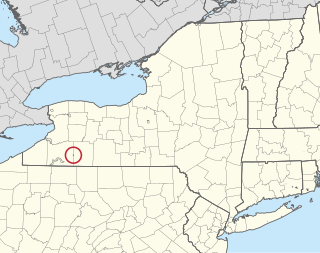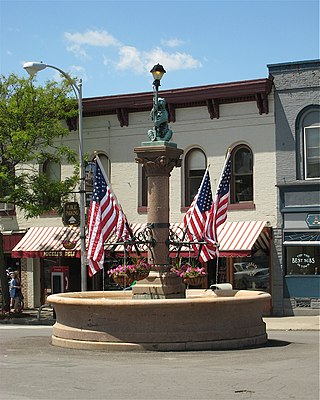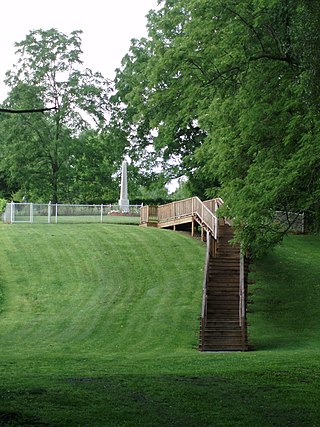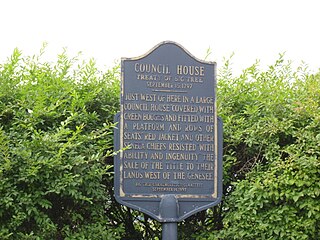Related Research Articles

Livingston County is a county in the U.S. state of New York. As of the 2020 census, the population was 61,834. Its county seat is Geneseo. The county is named after Robert R. Livingston, who helped draft the Declaration of Independence and negotiated the Louisiana Purchase. The county is part of the Finger Lakes region of the state.

Letchworth State Park is a 14,427-acre (5,838 ha) New York State Park located in Livingston County and Wyoming County in the western part of the State of New York. The park is roughly 17 miles (27 km) long, following the course of the Genesee River as it flows north through a deep gorge and over several large waterfalls. It is located 35 miles (56 km) southwest of Rochester and 60 miles (97 km) southeast of Buffalo, and spans portions of the Livingston County towns of Leicester, Mount Morris and Portage, as well as the Wyoming County towns of Castile and Genesee Falls.
Groveland is a town in Livingston County, New York, United States. The population was 3,249 at the 2010 census. The town is centrally located in the county, south of Geneseo.

The Tonawanda Indian Reservation is an Indian reservation of the Tonawanda Seneca Nation located in western New York, United States. The band is a federally recognized tribe and, in the 2010 census, had 693 people living on the reservation. The reservation lies mostly in Genesee County, extending into Erie and Niagara counties. It is bordered by the Towns of Alabama, Pembroke, Newstead, and Royalton.

Oil Springs Reservation or Oil Spring Reservation is an Indian reservation of the federally recognized Seneca Nation that is located in southwestern New York, United States. As of the 2010 census, the Indian reservation had one resident; in 2005 no tribal members had lived on the property. The reservation covers about one square mile (2.6 km2), divided between the present-day counties of Allegany and Cattaraugus. The reservation is northwest of the village of Cuba. It is bordered by the Town of Cuba and the Town of Ischua.

Avon is a village in the town of Avon, Livingston County, New York, United States. The village population was 3,394 at the 2010 census, out of 7,146 people in the entire town. The village and town are named after the River Avon in England.
Leicester is a town in Livingston County, New York, United States. The population was 2,200 at the 2010 census. The town is named after Leicester Phelps, an early inhabitant.

The 1779 Sullivan Expedition was a United States military campaign during the American Revolutionary War, lasting from June to October 1779, against the four British-allied nations of the Iroquois. The campaign was ordered by George Washington in response to Iroquois and Loyalist attacks on the Wyoming Valley, German Flatts, and Cherry Valley. The campaign had the aim of "taking the war home to the enemy to break their morale." The Continental Army carried out a scorched-earth campaign in the territory of the Iroquois Confederacy in what is now western and central New York.
The Seneca are a group of Indigenous Iroquoian-speaking people who historically lived south of Lake Ontario, one of the five Great Lakes in North America. Their nation was the farthest to the west within the Six Nations or Iroquois League (Haudenosaunee) in New York before the American Revolution. For this reason, they are called “The Keepers of the Western Door.”

The Genesee River is a tributary of Lake Ontario flowing northward through the Twin Tiers of Pennsylvania and New York in the United States. The river contains several waterfalls in New York at Letchworth State Park and Rochester.

The Phelps and Gorham Purchase was the sale, in 1788, of a portion of a large tract of land in western New York State owned by the Seneca nation of the Iroquois Confederacy to a syndicate of land developers led by Oliver Phelps and Nathaniel Gorham. The larger tract of land is generally known as the "Genesee tract" and roughly encompasses all that portion of New York State west of Seneca Lake, consisting of about 6,000,000 acres (24,000 km2).

Geneseo is a town in Livingston County in the Finger Lakes region of New York, United States. It is at the south end of the five-county Rochester Metropolitan Area. The population of the town was 10,483 at the 2010 census.

The Boyd and Parker ambush was a minor military engagement in what is now Groveland, New York on September 13, 1779, during the American Revolutionary War. A scouting patrol of the Sullivan Expedition was ambushed by Loyalist soldiers led by Major John Butler and their Seneca allies led by Cornplanter and Little Beard.

Mary Jemison (Deh-he-wä-nis) was a Scots-Irish colonial frontierswoman in Pennsylvania and New York, who became known as the "White Woman of the Genesee." As a young girl, she was captured and adopted into a Seneca family, assimilating to their culture, marrying two Native American men in succession, and having children with them. In 1824, she published a memoir of her life, a form of captivity narrative.

Cuylerville is a hamlet in the Town of Leicester, in Livingston County, New York, United States. The population was 297 at the 2010 census, which lists the community as a census-designated place.
Canawaugus was a Seneca Indian village. The village was located on the west side of the Genesee River, "about a mile above the ford", on the eastern edge of the Town of Caledonia. It was nearly opposite of the Avon sulphur springs. The name means "stinking waters" because of the sulphur.
Little Beard or Si-gwa-ah-doh-gwih, was a Seneca chief who participated in the American Revolutionary War on the side of Great Britain. After the war, he became reconciled with the outcome and continued to reside in New York.

The Treaty of Big Tree was a formal treaty signed in 1797 between the Seneca Nation and the United States, in which the Seneca relinquished their rights to nearly all of their traditional homeland in New York State—nearly 3.5 million acres. In the 1788 Phelps and Gorham Purchase, the Haudenosaunee (Iroquois) had previously sold rights to their land between Seneca Lake and the Genesee River. The Treaty of Big Tree signed away their rights to all their territory west of the Genesee River except 12 small tracts of land for $100,000 and other considerations. The money was not paid directly to the tribe, but was to be invested in shares of the Bank of the United States, and to be paid out to the Senecas in annual earnings of up to six percent, or $6,000 a year, on the bank stock.

Indian Captive: The Story of Mary Jemison is a children's biographical novel written and illustrated by Lois Lenski. The book was first published in 1941 and was a Newbery Honor recipient in 1942.Indian Captive is a historical fiction book retelling the life of Mary Jemison, with a few minor twists.

Boyd & Parker Park and Groveland Ambuscade is a historic park area located near the Town of Groveland in Livingston County, New York. The site commemorates the Boyd and Parker ambush, which took place during the Sullivan Expedition of the American Revolutionary War of September 1779.
References
- ↑ Norton, A. Tiffany (1879). History of Sullivan's Campaign Against the Iroquois. Lima, New York: A. Tiffany Norton, Publisher. p. 166.
A. Tiffany Norton.
- ↑ "Boyd-Parker Torture Tree - Leicester, NY". Historic Trees on Waymarking.com. Retrieved 2013-11-11.
- 1 2 "Historical, Ambuscade Monument". Town of Groveland, New York. Retrieved 2013-11-11.
- ↑ "Boyd-Parker Torture site, Genesee Castle" . Retrieved 2013-11-11.
- ↑ "Mary Jemison". Ohio History Central. Retrieved 2013-11-11.
- ↑ Seaver, James E (1823). "Chapter 7 ... Sullivan comes on to Genesee Flats and destroys the property of the Indians". A Narrative of the Life of Mrs. Mary Jemison. Retrieved 2013-11-11.
- ↑ Altsheler, Joseph A. "Chapter XXII. Little Beard's Town". The Scouts of the Valley. Retrieved 2013-11-11.
- ↑ Quigley, Kellen (December 31, 2022). "Seneca Nation purchases ancestral Genesee Valley land". The Salamanca Press . Retrieved 2022-12-31.
- ↑ "225th Anniversary Groveland Ambuscade". Selin's Rifles, Revolutionary War Reenactors. Retrieved 2013-11-11.